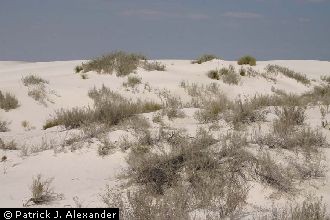Frosted Mint
Scientific Name: Poliomintha incana (Torr.) A. Gray

| General Information | |
|---|---|
| Usda Symbol | POIN3 |
| Group | Dicot |
| Life Cycle | Perennial |
| Growth Habits | ShrubSubshrub, |
| Native Locations | POIN3 |
Plant Guide
Alternate Names
Rosemary mint, purple sage , Use soil moisture sensors to measure the soil moisture of Frosted Mint.
Uses
Ethnobotanic: Comanche medicine women chewed the leaves of frosted mint to sweeten the taste of other drugs. The Hopi and Tewa used frosted mint to treat rheumatism and ear trouble. They also used the flowers for flavoring in food preparation.
Status
Please consult the PLANTS Web site and your State Department of Natural Resources for this plant’s current status (e.g. threatened or endangered species, state noxious status, and wetland indicator values).
Description
General: Mint Family (Labiatae). Frosted mint is a shrub that reaches 5 dm in height and is very branched. The branches are straight, slender, and erect. The branches have a silvery color and a dense covering of small hairs. The leaves are attached directly to the branches without a supporting stalk. The leaves are long and narrow with almost parallel sides (1-3 cm long). The leaves are veinless and covered with white, soft, wooly hairs. The flowers grow in groups of 1 to 3 and are located below their axils. The flowers are 6 to 7 mm long. The calyx has 15 simple veins, is oblong shaped, and covered with white, soft, shaggy hairs. The calyx has conspicuous awl-shaped teeth. The corollas are 1 to 1.4 cm long and have a lavender color with purple dots on the lower lip. The tube of the corolla has long, soft, straight hairs in the form of a ring. Distribution: For current distribution, please consult the Plant Profile page for this species on the PLANTS Web site. © Ronald Martin Intermountain Wildflowers Southern Utah University Habitat: Frosted mint is found on eroded slopes and in sandy soils.
Pests and Potential Problems
Grown in its native habitat and using local seed stock, frosted mint should not be prone to debilitating pests. Cultivars, Improved, and Selected Materials (and area of origin) These materials are readily available from commercial plant sources. Contact your local Natural Resources Conservation Service (formerly Soil Conservation Service) office for more information. Look in the phone book under ”United States Government.” The Natural Resources Conservation Service will be listed under the subheading “Department of Agriculture.”



